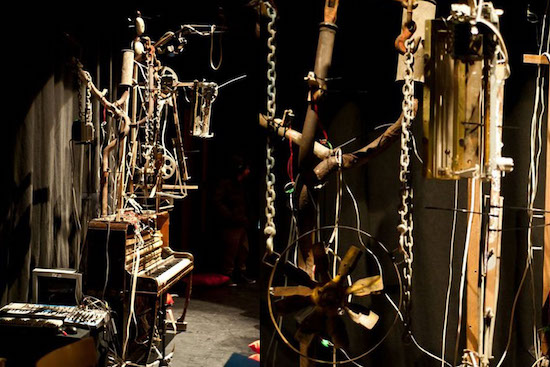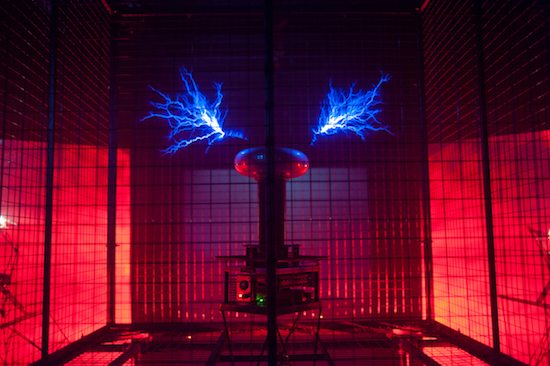XFRMR, Robbie Thomson, Credit: Tommy Ga-Ken Wan
Artist Robbie Thomson specialises in kinetic sculpture, sonic art and lighting design to exhilarating ends. He is actively engaged in the art scene in Glasgow, working with artist collectives, theatre companies, and supporting independent art spaces. It was at the internationally acclaimed Glasgow School of Art, that Thomson first found a testing ground for his instincts in performance. “I started out experimenting in actionist performance before getting into playing with the mechanical stuff – making drawing performances using machines and sound performances that would be automated.” Early references that informed Thomson’s enquiries are confrontational performance artists Ron Athey and Stelarc, whose practices are oriented around body art, extreme performance art, and employing robotics to extend the human body’s capabilities. A source of huge inspiration on his doorstep was Russian Sculptor-mechanic Eduard Bersudsky and his Sharmanka Kinetic Gallery – a collaborative project with theatre director Tatyana Jakovskaya and light and sound designer Sergey Jakovsky. Founded in St Petersburg in 1989, it has been based in Glasgow since 1995.
In 2009, whilst on the Sculpture and Environmental Art program at Glasgow School of Art, Thomson specialised in performance, video and new media. He played with dramatic conventions like lighting design, and “jumped about a lot with kinetic sculptures, and made crude, mechanical assemblages combined with performance.” These early works are spectacular and uncanny as they reproduce life-like motions and emotions in inanimate materials. These pieces demonstrate an entry point into the immersive, sensory experiences Thomson has gone on to create.
Thomson’s degree show sparked the interest of Cathie Boyd, director of Glasgow based, internationally-renowned producing art house, Cryptic, and he has been on their select Associate Artist program since 2013. Cryptic presents today’s most imaginative, innovative artists crossing creative boundaries with multi-media performances that fuse music, sonic and visual art. Soon after graduating, Thomson received his first commission to produce a work for Cryptic Nights. Recognising the need for a regular, supportive platform for emerging Scottish based artists with fresh ideas, Cryptic launched Cryptic Nights in 2009 and have to date, presented over 200 artists in partnership with the Centre for Contemporary Arts (CCA) in Glasgow.
The piece he produced, Idimov (2010), was made of simple, robotic parts in an intricate arrangement of objects that moved to create sounds and operate a piano to form an eerie, acoustic melody. The piece was further developed into an immersive production with fellow artist friends at 85A – an artist collective that developed and produced multi-disciplinary large scale installations between 2008 and 2014. The final result was Idimov and the Dancing Girl(2011), which featured a full, mechanically functioning orchestra; a libretto written by Craig Bayne; was manned by a band of masked MuMu performers; included a video mapped narrator, puppet show barkers and a large scale set and frontage.
Thomson often collaborates with composers, dancers, actors and mechanical engineers to bring to life his fervent compositions that discuss our interaction with technology. His ideas are built around what happens when we impose various conditions on technology, and how it influences our relationships psychologically – from technological transgressions in The Eye (2014); environmental issues, power consumption and aerospace engineering in Ecstatic Arc (2012); and AI and mental illness in The Influencing Machine (2016).

Idimov, credit: Robbie Thomson
Next week Robbie Thomson brings his latest work, XFRMR to the Brighton Festival – an annual celebration of music, theatre, dance, circus, art, film, literature, debate, outdoor and family events across Brighton & Hove for three weeks every May. The name, XFRMR he tells me, is shorthand in physics for an electrical transformer. This piece, displaying around 250,000 volts of electricity up close in its raw state, has grown out of Ecstatic Arc, an immersive work produced for Cryptic’s Sonica Festival in 2012.
XFRMR is centred around a Tesla coil and Faraday cage. The Tesla coil was built by mechanical engineer and programmer Steve Conner. Thomson tells me he tracked Conner down after watching his work on Tesla coils on YouTube. “Steve engineered the complicated part of the electronics that actually makes it work!” In Conner’s words, “a Tesla coil is a kind of high voltage generator invented by Nikola Tesla at the turn of the century. They make a beautiful display of sparks and a hell of a scary noise.”
Staged within a Faraday cage to contain the Tesla coil’s electric charges, XFRMR explores its sonic possibilities and uses the sounds of the electromagnetic fields as source material for the composition. Thomson operates the performance with a minimalist soundtrack created via a laptop and synthesiser, whilst the Tesla coil creates unusual yet beautifully tonal sounds. Certain arrangements he revisits for each reinvention of the performance, and other moments are improvised responses to the given environment.
”I have an interface that can accept any audio signal and work them into pulses to be played back through the coil,” he says. “The tonal or percussive sounds that are a bit distorted and nasty are coming directly from the coil’s acoustics as the energy flows through it – it is a direct experience: what you see is what you hear.”
In contrast to the darker themes of Thomson’s works, XFRMR is more free in its conception. He treats the Tesla coil as a composition, with no signifiers except those present through sound and light to create a pure spectacle. Yet beyond the immediacy and aesthetics of the audio visual, one can sense a deeper, more visceral meaning.
“The proximity of this power in its raw physical state and its convulsive, hypnotic complexities, the smell of Ozone – is exciting to me because it visualises something directly about the subatomic relationships that govern the world – from the structure of cells to the microprocessor … it is the visualisation of forces that are kind of hidden. It’s quite beautiful seeing it as a force that exists in its own right; to be able to see the electricity and plasma and the beautiful patterns that exist for a fraction of a second, not just something created to serve our needs.”
Through this work Thomson instils a sense of wonder as the naturally occurring manifestations of the laws of physics are reproduced in a synthetic way. In the presence of high voltage equipment, where the electrical energy becomes a physical thing, Thomson has created a stage for the senses. The Faraday cage contains the 250,000 volts of energy safely so that one can marvel in its beauty and potential danger simultaneously – the perfect components for a sublime experience.
Robbie Thomson performs XFRMR at The Spire, Brighton, as part of the Brighton Festival, from Wednesday 16 May – Sunday 20 May


